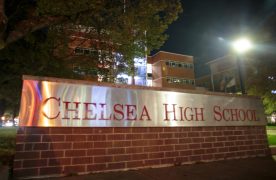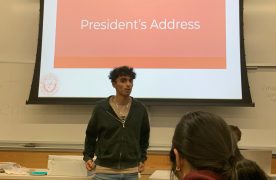The argument is not new. It has pervaded newsrooms across the country for decades, sparking debate and outrage from minority readers. And in a city like Boston, where ‘minorities’ are actually the majority, reports have shown the question is valid: How can mainstream media, still overwhelmingly dominated by whites, accurately represent a diverse society?
Media and social organizations such as the American Society of Newspaper Editors, NAACP, the National Association of Hispanic Journalists, have frequently examined this question through surveys, analyses and various recruitment programs to increase minority employment. Six months ago, The Boston Globe addressed the issue as well.
In an analysis of 1,448 daily newspapers across the country, the Globe reported that 125 newspapers have a percentage of minority employment that exceeds that of their circulation area, 501 have less than or equal to half the minority percentage, and 292 won’t say – meaning that almost 50 percent of daily newsrooms are completely white.
According to former ASNE President and Boston University journalism professor Bill Ketter, newsroom diversity is crucial to presenting ‘a whole picture’ of the community it serves.
‘Newspapers should be a mirror to reflect the community,’ he said. ‘They need to have a rainbow of editors, reporters, photographers … Otherwise, they don’t reflect the community.’
In Boston, where minorities make up 51 percent of the city population, their representation in newsrooms and in coverage is far less. While the Globe has made a conscious effort to employ more minorities (18.3 percent, according to the report) than populate its circulation (15.8 percent), many people still argue that certain minority areas, such as Roxbury, Dorchester and Mattapan, are largely excluded from mainstream media coverage and cast in a negative light.
‘Wherever there are large populations of people of color you get negative stories,’ said NAACP Boston Branch President Leonard Alkins, a Boston native. ‘This issue has been a concern for years … There needs to be a rethinking about fairness and equity when we write about communities throughout Boston. There needs to be fairness applied as you write about the negative issues you also have to write about the positive ones.’
He emphasized the role that diversity plays in presenting balanced coverage.
‘[If editors] are not diverse, you get this kind of negative reporting because of the choices of assignment editors who don’t come from these communities and can’t relate,’ he said. ‘You need to have assignment editors who are perceptive and proactive and morally concerned about the impact that a negative story has upon a community.’
Ketter agreed, contending newsroom diversity is important in maintaining the integrity of a news organization as well as a good business practice.
‘Without a diverse staff, newspapers are more susceptible to bias,’ he said.
Yawu Miller, managing editor of the weekly Boston Banner, which focuses on coverage of Boston’s ethnic communities, pointed out that over-reliance on a single [minority] source can leave reporters susceptible to biased coverage.
‘The complaint I hear the most is that many reporters use the same [minority] sources over and over again,’ Miller said. ‘They need to increase the number of people of color in their Rolodex.’
In 1994, a 56-page critical study entitled ‘News Watch: A Critical Look at Coverage of People of Color,’ produced by the Center for Integration and Improvement of Journalism at San Francisco State University determined media coverage of minorities was ‘riddled with old stereotypes, offensive terminology [and] biased reporting.’
Eight years later, these feelings persist not only in Boston, but across the nation.
George Ramos, a three-time Pulitzer Prize-winning Los Angeles Times reporter and founding member of the National Association of Hispanic Journalists, says being a Mexican is the hardest thing he has had to overcome as a journalist.
When he began at the Times 25 years ago, he was one of two Latinos in the newsroom. He said his beginning years were spent covering stories his editors thought ‘only a Mexican could do.’
‘It was like, ‘you go deal with your people,” Ramos said.
One of the greatest recent outcries against media reportage came in response to the coverage of a young white woman who was raped by a group of black and Latino teenagers while running through Central Park in Manhattan at night. Her story made headlines across New York and dominated the news for months, as local media profiled the accused attackers, investigated their families, examined their neighborhood, and emphasized the brutality of the crime. The accused attackers were described as ‘wolves,’ ‘savages’ and ‘mutants’ in various New York news sources.
That same night, in a different part of town, seven murders and eight shootings took place. The body of a black woman was found under a highway in the Bronx after being bashed with a cinder block, sexually abused with a pipe and shot in the head.
Two days later, a black, off-duty mailman was gunned down in Harlem. And a week after that, a young, black mother of four was raped at knife-point, brutally beaten and thrown from the roof of her 21-story Harlem apartment building where she had been watching the sunset. Grabbing hold of a television cable, the woman dangled naked and bleeding from the side of her apartment complex until she was rescued.
Her story, along with the seven others, received passing notice in local papers.
Readers were outraged.
As Pamela Newkirk, assistant professor of journalism at New York University points out in ‘Within the Veil: Black Journalists, White Media,’ ‘If the Central Park jogger had been a black woman, even an affluent one, few believe that the media coverage would have been as prominent or as prolonged.’
Such blatant imbalances in reporting, critics said, were demonstrative of the white bias that still exists in many newsrooms.
Ketter maintains this is precisely why diversity is so important it helps ‘cross [racial] divides.’
In 1978, when ASNE first determined that minority hiring in newsrooms was insufficient, they declared the year 2000 as the goal for achieving a minority employment equal to that of the minority population. But as its unattainability became increasingly clear, ASNE abandoned its goal – replacing it with a reduced objective of 20 percent by 2010.
This is an account occasionally used by the Daily Free Press editors to post archived posts from previous iterations of the site or otherwise for special circumstance publications. See authorship info on the byline at the top of the page.












